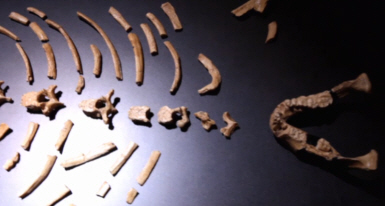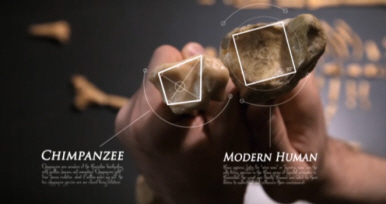Chimpanzee Skeleton - Lucy
Origins of Us - Bones
To nail down when we became walking rather than climbing apes, scientists at Boston University have been studying the bones of our ancient ancestors with laser-like precision. They've analysed the remains of every fossil they could lay their hands on, including the bones of this truly remarkable fossil - Lucy
She belongs to a species called Australopithecus afarensis. This is a replica of Lucy, who is one of the most famous, if not the most famous skeletons in the whole of human evolution. She's 3.2 million years old, and we have so much of her skeleton that we can tell an enormous amount about her. She would have stood just over a metre tall. The length of her arms and her curved fingers suggest that climbing was still really important in the way she got around. But, recent research is challenging that idea.

There's one area of Lucy's skeleton that's been the focus of Jeremy DeSilva's exciting new research. "Lucy has a spectacular ankle, and chimpanzees do remarkable things with their feet and ankles. They could take the top of their foot and press it right up against their shin. It's amazing flexion, which if you and I tried that, we'd snap ligaments or our Achilles, we just aren't equipped for thatkind of motion. A big ape like a chimpanzee, putting all of its body on the foot and the anklewhile its climbing, leaves its mark on the bones"

On the left is the bottom of a chimpanzee's tibia, or shin bone, where it forms the ankle joint, and there's a very obvious trapezoid shape. On the right is the same area of the human tibia, and it's square.
The shape of your bones reflects whether you use your ankles for climbing or for walking.
Looking at Lucy's bones we see that the shape of her tibia is much more human-like. Jeremy DeSilva "It is, and that tells us that her feet were planted firmly on the ground, directly underneath her knees, adaptations we see in upright walking creatures."
Lucy still appears very ape-like, and her brain is similar in size to that of a chimpanzee. But, becoming a walking ape had fundamentally changed the shape of her body.
